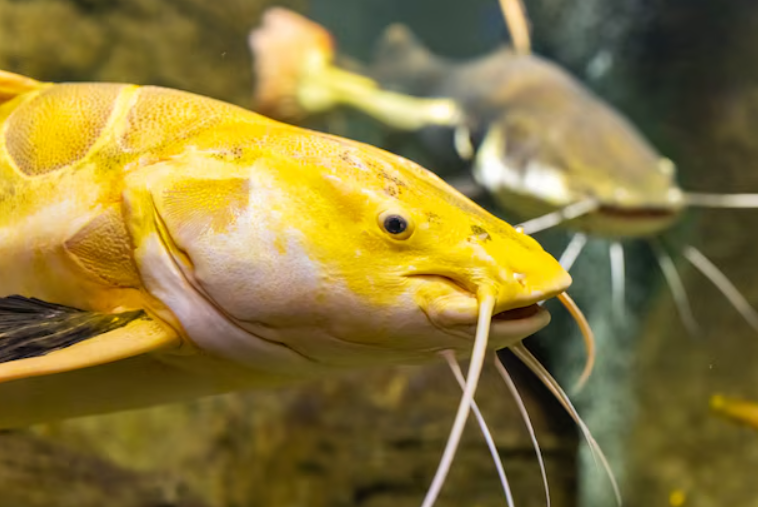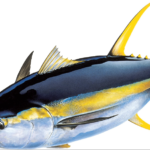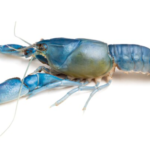A Hands-on Guide to the Intriguing Yellow Bullhead Catfish
Throughout North America, freshwater rivers, lakes, and ponds are home to the fascinating Yellow Bullhead Catfish (Ameiurus natalis). Anglers often pursue this species because of its worth and difficulty in sport fishing, as well as its remarkable look and persistent behaviour. The Yellow Bullhead Catfish, a popular target for both commercial and recreational fishermen, is an essential component of aquatic ecosystems due to its distinctive yellowish colour and sturdy physical characteristics. The physical traits, habitat, nutrition, behaviour, and conservation status of the Yellow Bullhead Catfish are all covered below:
Quick Top 10 Facts about Yellow Bullhead Catfish
| SCIENTIFIC NAME | Ameiurus natalis (Yellow Bullhead Catfish) |
| CLASSIFICATION | KINGDOM: Animalia CLASS: Actinopterygii ORDER: Siluriformes FAMILY: Ictaluridae PHYLUM: Chordata GENUS: Ameiurus |
| SIZE | Up to 24 inches (61 cm) in length and can weigh up to 8 pounds (3.6 kg) |
| HABITAT | Found in freshwater environments, including rivers, lakes, and ponds in North America |
| DIET | Omnivorous – Feeds on fish, insects, mollusks, and plant matter |
| SPECIES | Yellow Bullhead Catfish (*Ameiurus natalis*) |
| COUNTRY | Native to North America, primarily in the United States and parts of Canada |
| GESTATION PERIOD | Eggs hatch within 1-2 weeks after fertilization |
| LIFE SPAN | Up to 8 years in the wild |
| CONSERVATION STATUS | Not endangered, the species is widely distributed and common in North American freshwater habitats |
Physical Features of the Yellow Bullhead Catfish
Among other catfish species, the Yellow Bullhead Catfish is unique due to a number of characteristics. It usually has a hefty, stocky body with scaleless, smooth skin. The fish may be bright yellow, olive green, or brown in colour, and its underside is often pale. Its darker dorsal and tail fins contrast with its pale body, which is particularly apparent in juveniles. Their distinctive colour frequently comes from the deepening of the yellowish tint as they age.
Dimensions and Look
With some exceptional specimens reaching up to 30 inches in length, adult Yellow Bullhead Catfish can develop to a maximum size of 18 to 24 inches. In order to find food in murky water, these catfish use their large, fleshy barbels and broad heads as sensing organs. Often called “whiskers,” these barbels give the species its distinctive look and set it apart from other freshwater fish. A degree of defence against predators is provided by the large, triangular head and the strong spines in the dorsal and pectoral fins.
Distribution and Habitat
Native to North America, yellow bullhead catfish may be found in freshwater lakes, ponds, and rivers. They are mostly found in the central United States, which stretches from the Great Lakes to the Gulf of Mexico. Because of their adaptability, these catfish may live in a variety of water types, such as marshes, stagnant ponds, and slow-moving rivers, where the temperature can vary from 60°F to 80°F (15°C to 27°C).
Preferred Environment
Their fondness for muddy or sandy substrates, which make it simple for them to bury themselves for protection or to rest, is one of the characteristics that distinguish their habitat. Because they can hide from predators and powerful currents, they are often found in places with a lot of foliage or submerged objects like boulders and fallen logs.
Adaptability to Water Conditions
Because of their exceptional tolerance for low water oxygen levels, yellow bullhead catfish are ideal for habitats that other fish species could find difficult to live in. Their flexibility and durability are shown by their capacity to withstand a variety of water conditions.
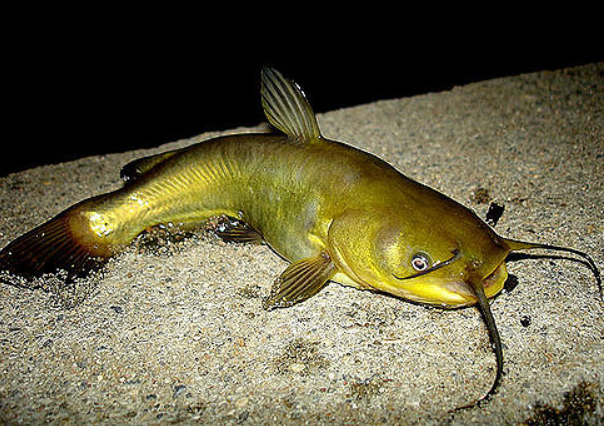
Diet and Feeding Practices
Yellow Bullhead Catfish are omnivorous bottom feeders that eat a broad range of foods. They eat debris, insects, tiny fish, crabs, and aquatic plants. They are adept scavengers, using their sensitive barbels to find food in muddy, dark waters.
The Ecological Function of Food
Their eating patterns have a significant ecological impact in the wild. The yellow bullhead catfish contributes to the ecosystem’s health by eating dead plants and animals. By doing this, they lessen the accumulation of decomposing organic waste that may otherwise degrade the quality of the water. Additionally, because of their food, they may flourish in environments where other fish would not be as adaptive, guaranteeing their continued significance as a species in their natural settings.
Patterns of Nighttime Feeding
The Yellow Bullhead Catfish is more active at night during the warmer months, eating in the chilly evenings. While they may be opportunistic eaters, Yellow Bullheads are more likely to pursue slow-moving food like tiny invertebrates and minnows. On occasion, bigger individuals may feed on other fish species or tiny amphibians.
Social Structure and Behavior
Although they are usually solitary, yellow bullhead catfish may sometimes be encountered in small groups, particularly during breeding seasons. Because they prefer to stay in their selected environment and only travel small distances when required, they are considered to be somewhat sedentary. They often bury themselves in mushy, soft surfaces when not eating or mating in order to hide from predators.
Sleeping Patterns and Nocturnal Behaviour
This species of catfish feeds mostly at night and is typically nocturnal. Yellow bullheads often rest behind objects like rocks, logs, or foliage throughout the day. They are believed to be defending themselves from bigger predators by engaging in this behaviour.
Behaviour in the Territories During the Breeding Season
Although territorial behaviour may be seen, especially among males during the mating season, these fish are not very hostile towards one another. Males may protect an area they believe to be their own, such as a nesting place. However, these cyclical periods are often the only occasions when the hostile behaviour occurs.
The Lifespan and Reproduction
The Yellow Bullhead Catfish has an interesting reproductive cycle. When the water temperature reaches about 70°F (21°C) in the late spring or early summer, these catfish usually reproduce. Nests are built and guarded by males in isolated locations with sluggish water and thick vegetation. These nests are often found in shallow depressions in the ground, under submerged items, or in hollows.
Nesting and Parenting
The guy makes room and gets the nest ready after luring a female. The male fertilises the eggs that the female puts in the nest. The male Yellow Bullhead Catfish protects the nest until the eggs hatch, which normally happens in a few days. Yellow Bullhead Catfish are renowned for their paternal care. Until the young can swim and feed themselves, the male will keep watching over them.
Lifespan in Captivity and the Wild
In the wild, yellow bullhead catfish often live for five to seven years. However, if given the best surroundings possible, they may survive longer in captivity. Their lifetime may be greatly impacted by variables including food availability, environmental stresses, and water quality.
Relevance to the Environment
In its ecology, the yellow bullhead catfish is essential. It contributes to the equilibrium of organic matter in its surroundings as a bottom feeder. By preventing the accumulation of debris and rotting waste, their feeding practices help to maintain a cleaner and healthier aquatic environment for other species.
Contribution to the Biodiversity
They also play a significant role in the food chain. Yellow Bullhead Catfish, particularly young ones, are often preyed upon by larger fish and animals, such as birds and mammals. They support the general biodiversity and equilibrium of their environment by feeding a variety of predators.
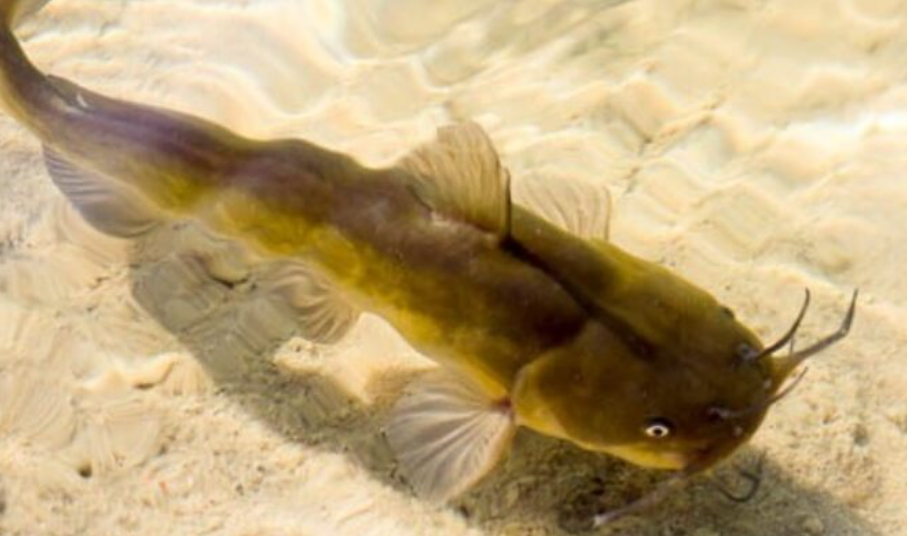
Recreational fishing and angling
Because of their abundance and difficult character, yellow bullhead catfish are highly valued by fishermen. The Yellow Bullhead offers an interesting and entertaining catch, despite being smaller than some of its cousins, such as the Flathead or Channel Catfish. Anglers often use artificial lures or live bait, such as worms or tiny minnows, to target these fish.
Tips and Techniques for Fishing
Yellow Bullhead Catfish are difficult to capture because they like to hide on soft substrates or thick vegetation. Anglers may catch them in both small lakes and bigger rivers since they are more likely to bite in the warmer months and are often located in shallow, weedy environments.
How to Safely Handle Yellow Bullhead Catfish
Because these catfish have sharp spines in their fins, anglers should be mindful that handling them incorrectly may result in severe injuries. Yellow Bullhead Catfish must be handled carefully, and if they are not being kept, they must be gently returned to the water.
Threats and Conservation
The habitat of the Yellow Bullhead Catfish may be threatened by a number of factors, even though it is not presently classified as a threatened or endangered species. Overfishing, pollution, and habitat degradation may all have a detrimental impact on these fish populations, especially in places where human activity is considerable. Competition for food and habitat resources may also arise from the introduction of non-native animals.
Preservation of Natural Environments
The Yellow Bullhead Catfish’s existence depends on conservation initiatives that safeguard freshwater environments. These fish may continue to flourish in their natural environments thanks to efforts to protect wetlands, river systems, and natural watercourses. In order to preserve healthy populations of this species for the next generations, sustainable fishing methods are also essential.
FAQ (frequently asked questions) about Yellow Bullhead Catfish
Q: What is a Yellow Bullhead Catfish?
Ans: The Yellow Bullhead Catfish is a freshwater fish species, scientifically known as Ameiurus natalis, found in North America. It is recognized for its yellowish body and broad, flat head.
Q: Where do Yellow Bullhead Catfish live?
Ans: Yellow Bullhead Catfish are typically found in slow-moving rivers, ponds, lakes, and marshes, particularly in the eastern United States and parts of Canada.
Q: What do Yellow Bullhead Catfish eat?
Ans: Yellow Bullhead Catfish are omnivores, feeding on a variety of food such as insects, small fish, crustaceans, and plant material.
Q: How do Yellow Bullhead Catfish defend themselves?
Ans: Yellow Bullhead Catfish have sharp spines in their dorsal and pectoral fins, which they use to defend themselves against predators.
Q: How do Yellow Bullhead Catfish reproduce?
Ans: Yellow Bullhead Catfish reproduce by laying eggs, with the female choosing a suitable nesting site. The male guards the eggs until they hatch.
Q: Are Yellow Bullhead Catfish good for aquariums?
Ans: While Yellow Bullhead Catfish can be kept in aquariums, they require large tanks with adequate space, as they grow to a sizable length and need appropriate water conditions.
Q: How long do Yellow Bullhead Catfish live?
Ans: Yellow Bullhead Catfish can live up to 10 years in the wild, although their lifespan in captivity may vary based on care and environment.
Q: What are the characteristics of Yellow Bullhead Catfish?
Ans: Yellow Bullhead Catfish are characterized by their yellowish to olive-green coloration, broad flat head, and long barbels (whiskers) around their mouth.
Q: Do Yellow Bullhead Catfish have any natural predators?
Ans: Yes, natural predators of the Yellow Bullhead Catfish include larger fish, birds, and some mammals that prey on small fish in freshwater environments.
Q: Are Yellow Bullhead Catfish endangered?
Ans: Yellow Bullhead Catfish are not considered endangered, though local populations can be affected by habitat destruction and water pollution.
#YellowBullheadCatfish, #BullheadCatfish, #Catfish, #FreshwaterFish, #FishingLife, #CatfishFishing, #AquaticLife, #FishLovers, #AnglerLife, #FishingCommunity, #WildlifePhotography, #CatchAndRelease, #FishTank, #AquariumLife, #OutdoorAdventure
Our sources and references about Yellow Bullhead Catfish
1: Wikipedia
2: American Rivers
3: FishBase
4: On the Water
